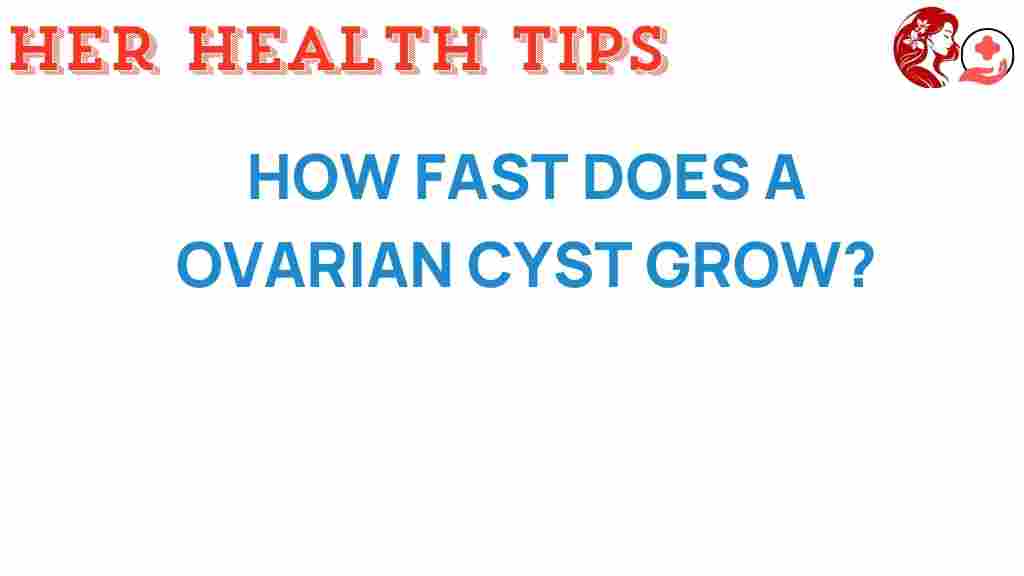The Surprising Truth: How Fast Does an Ovarian Cyst Grow?
Ovarian cysts are fluid-filled sacs that form on the ovaries, and they are a common occurrence in women of all ages. While many ovarian cysts are harmless and resolve on their own, understanding their growth rate is crucial for women’s health. In this article, we will explore the growth rate of ovarian cysts, their symptoms, diagnosis, and treatment options, while also delving into the latest medical research in gynecology.
Understanding Ovarian Cysts
Ovarian cysts can vary in size and type. The most common types include:
- Functional Cysts: These are the most prevalent and occur as part of the menstrual cycle. They typically resolve on their own.
- Dermoid Cysts: These contain various types of tissue and can grow larger over time.
- Endometriomas: These are linked to endometriosis and can cause pain and other symptoms.
While most cysts are benign, knowing how fast an ovarian cyst grows can help women recognize potential complications and seek appropriate medical attention.
What Affects the Growth Rate of Ovarian Cysts?
The growth rate of ovarian cysts can be influenced by several factors, including:
- Hormonal Changes: Fluctuations in hormones during the menstrual cycle can impact the formation and growth of cysts.
- Age: Younger women may experience different growth rates compared to those nearing menopause.
- Underlying Health Conditions: Conditions like polycystic ovary syndrome (PCOS) can lead to the formation of multiple cysts, potentially affecting their growth rate.
How Fast Does an Ovarian Cyst Grow?
The growth rate of ovarian cysts varies significantly. Functional cysts typically grow and resolve within a few menstrual cycles, while other types can grow more slowly or remain stable for longer periods. Here’s a general overview:
- Functional Cysts: These often appear during ovulation and can reach sizes of 2-5 cm. They usually resolve within 1-3 cycles.
- Dermoid Cysts: These can grow at variable rates, sometimes reaching sizes of 5-15 cm or more over several months or years.
- Endometriomas: These can grow slowly, often reaching sizes of 2-10 cm over time.
Research indicates that while some cysts might grow rapidly, others may remain stable or even shrink. Regular monitoring through ultrasound can help track the growth rate of cysts.
Symptoms of Ovarian Cysts
Many ovarian cysts do not cause symptoms, but when symptoms do occur, they may include:
- Pelvic pain or discomfort
- Menstrual irregularities
- Bloating or swelling in the abdomen
- Pain during intercourse
- Frequent urination or difficulty emptying the bladder
If you experience severe pain or symptoms suggestive of complications, seek medical attention promptly.
Diagnosis of Ovarian Cysts
Diagnosing ovarian cysts typically involves a combination of medical history, physical examination, and imaging tests. The common steps in the diagnostic process include:
- Medical History: Discussing symptoms and menstrual cycle with a healthcare provider.
- Physical Examination: A pelvic exam to check for abnormalities.
- Ultrasound: The most common imaging test to visualize cysts and assess their size and characteristics.
- Blood Tests: Hormonal levels may be checked, and in some cases, tumor markers may be assessed.
For more detailed information on diagnosis and treatment options, visit our women’s health resource page.
Treatment Options for Ovarian Cysts
Treatment for ovarian cysts depends on various factors, including the type of cyst, symptoms, and overall health. Here are common treatment options:
- Watchful Waiting: Many functional cysts resolve without treatment within a few menstrual cycles.
- Medications: Birth control pills may help regulate menstrual cycles and prevent new cysts from forming.
- Surgery: In cases of large or symptomatic cysts, surgical options such as laparoscopy or laparotomy may be necessary.
Recent Medical Research on Ovarian Cysts
Recent studies in medical research have focused on understanding the behavior of ovarian cysts and improving diagnostic techniques. Key findings include:
- Utilization of advanced imaging techniques to better differentiate between benign and malignant cysts.
- Research into the genetic factors that may influence the development and growth rate of cysts.
- Studies examining the effectiveness of different treatment protocols, including the use of hormonal therapy.
Ongoing research in gynecology aims to enhance our understanding of ovarian cysts and improve outcomes for women’s health.
Tips for Managing Ovarian Cysts
While ovarian cysts are often benign, here are some troubleshooting tips for managing them:
- Regular Check-ups: Maintain regular gynecological exams to monitor any cysts.
- Track Symptoms: Keep a record of any symptoms or changes in your menstrual cycle.
- Healthy Lifestyle: A balanced diet and regular exercise can support overall reproductive health.
- Open Communication: Discuss any concerns or symptoms with your healthcare provider promptly.
Conclusion
Understanding how fast an ovarian cyst grows is essential for women’s health management. While many cysts are benign and resolve on their own, recognizing symptoms, seeking timely diagnosis, and exploring treatment options are critical steps in addressing potential complications. With ongoing medical research and advancements in gynecology, women can have access to better resources and support for managing ovarian cysts effectively.
For more information on women’s health and ovarian cysts, consider visiting this external resource that provides comprehensive insights and support.
This article is in the category Reproductive and created by HerHealthTips Team
